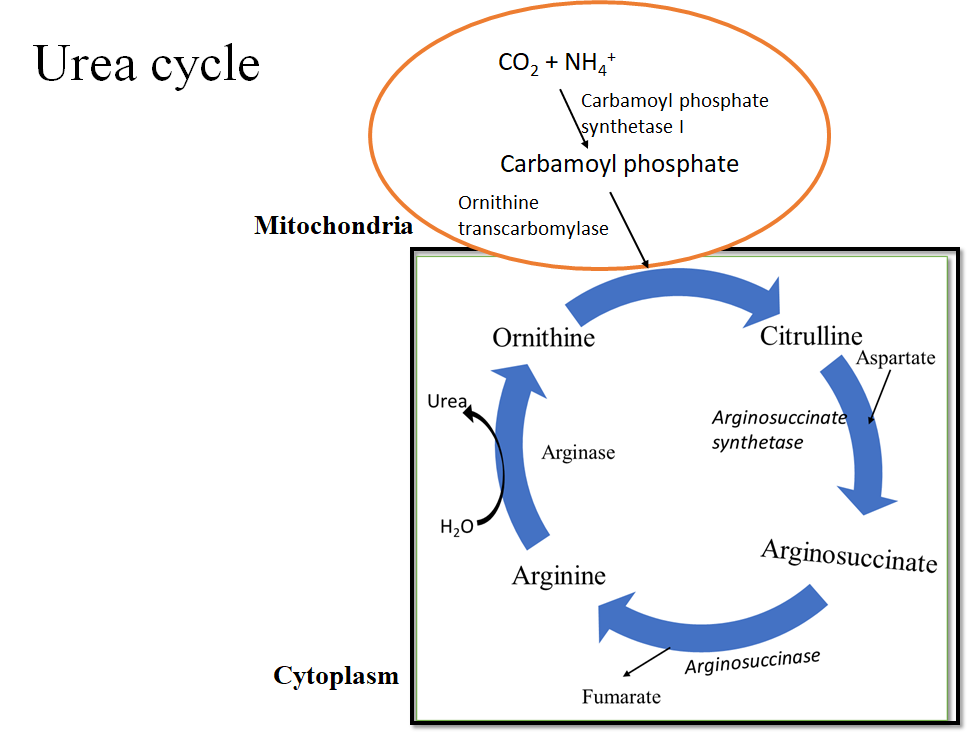
The end product of the ornithine cycle is-
(a)Urea
(b)Uric acid
(c)${ NH }_{ 3 }$
(d)${ CO }_{ 2 }$
Answer
546k+ views
Hint: The urea cycle (also known as the ornithine cycle) is a cycle of biochemical reactions that causes the conversion of ammonia, ${ NH }_{ 3 }$ into less toxic forms that need some water for elimination.
Complete answer:
Urea is the end product of the ornithine cycle. The urea cycle is essential to the organisms because if the nitrogen or ammonia are not eliminated from the organism it can be very detrimental. In uricotelic organisms such as birds and most insects, the ammonia is converted into uric acid or its urate salt, before getting excreted in the form of solid stool.
Additional Information:
The cycle starts with Carbamoyl phosphate being converted to citrulline with the help of the enzyme ornithine transcarbamoylase. A condensation reaction occurs between the aspartate and the citrulline to form argininosuccinate. This reaction is dependent on ATP and is catalyzed by argininosuccinate synthetase. The argininosuccinate formed undergoes breakdown by argininosuccinase to form arginine and fumarate. Arginine is finally cleaved by arginase to form urea and ornithine. The ornithine is then transported back to the mitochondria to supplement the next urea cycle.
There are other modes of excretion too:
Ammonotelism: The type of excretion in which organisms excrete ammonia. Example: Fishes, poriferans, etc.
Uricotelism: In this, the organisms remove uric acid and is commonly observed in reptiles, birds.
Certain Molluscs secrete amino acids which are known as aminotelism and spider convert ammonia into guanine for excretion known as guanotelism.
So, the correct answer is ‘Urea’.
Note: The ornithine cycle occurs in ureotelic organisms. This cycle was considered to be the first metabolic cycle to be discovered by Hans Krebs and Kurt Henselet, in 1932. The ornithine cycle occurs in the liver and accounts for the removal of nearly 90% of waste as urea.

Complete answer:
Urea is the end product of the ornithine cycle. The urea cycle is essential to the organisms because if the nitrogen or ammonia are not eliminated from the organism it can be very detrimental. In uricotelic organisms such as birds and most insects, the ammonia is converted into uric acid or its urate salt, before getting excreted in the form of solid stool.
Additional Information:
The cycle starts with Carbamoyl phosphate being converted to citrulline with the help of the enzyme ornithine transcarbamoylase. A condensation reaction occurs between the aspartate and the citrulline to form argininosuccinate. This reaction is dependent on ATP and is catalyzed by argininosuccinate synthetase. The argininosuccinate formed undergoes breakdown by argininosuccinase to form arginine and fumarate. Arginine is finally cleaved by arginase to form urea and ornithine. The ornithine is then transported back to the mitochondria to supplement the next urea cycle.
There are other modes of excretion too:
Ammonotelism: The type of excretion in which organisms excrete ammonia. Example: Fishes, poriferans, etc.
Uricotelism: In this, the organisms remove uric acid and is commonly observed in reptiles, birds.
Certain Molluscs secrete amino acids which are known as aminotelism and spider convert ammonia into guanine for excretion known as guanotelism.
So, the correct answer is ‘Urea’.
Note: The ornithine cycle occurs in ureotelic organisms. This cycle was considered to be the first metabolic cycle to be discovered by Hans Krebs and Kurt Henselet, in 1932. The ornithine cycle occurs in the liver and accounts for the removal of nearly 90% of waste as urea.

Recently Updated Pages
Master Class 11 Social Science: Engaging Questions & Answers for Success

Master Class 11 Physics: Engaging Questions & Answers for Success

Master Class 11 Maths: Engaging Questions & Answers for Success

Master Class 11 Economics: Engaging Questions & Answers for Success

Master Class 11 Computer Science: Engaging Questions & Answers for Success

Master Class 11 Chemistry: Engaging Questions & Answers for Success

Trending doubts
What is meant by exothermic and endothermic reactions class 11 chemistry CBSE

10 examples of friction in our daily life

One Metric ton is equal to kg A 10000 B 1000 C 100 class 11 physics CBSE

Difference Between Prokaryotic Cells and Eukaryotic Cells

1 Quintal is equal to a 110 kg b 10 kg c 100kg d 1000 class 11 physics CBSE

Draw a diagram of nephron and explain its structur class 11 biology CBSE




